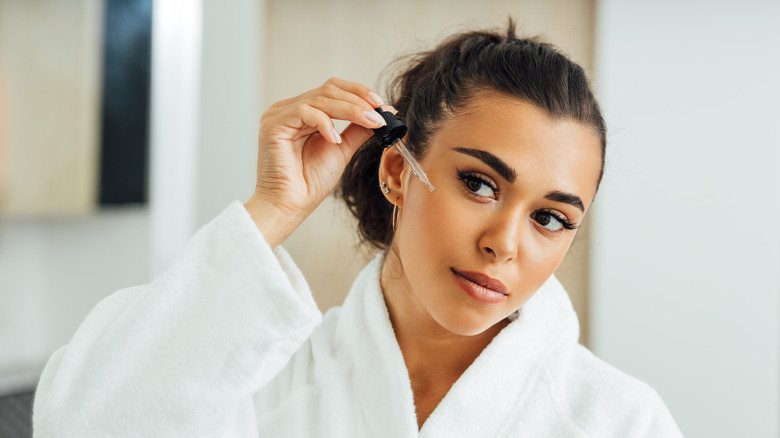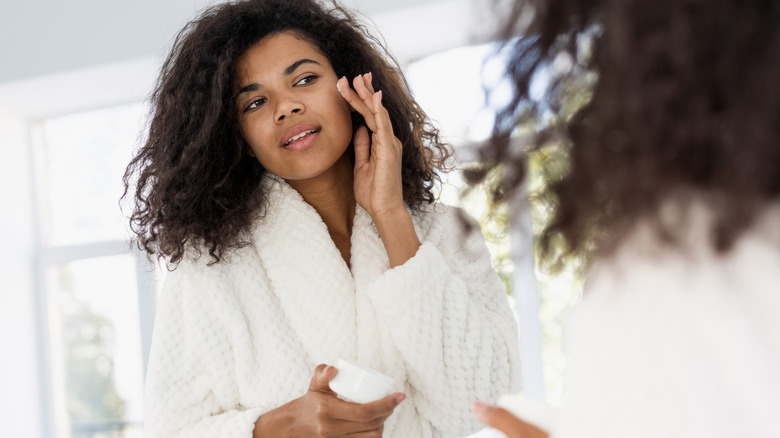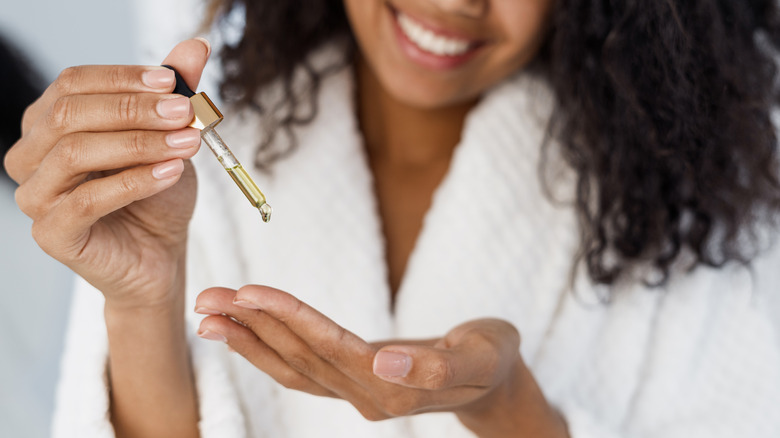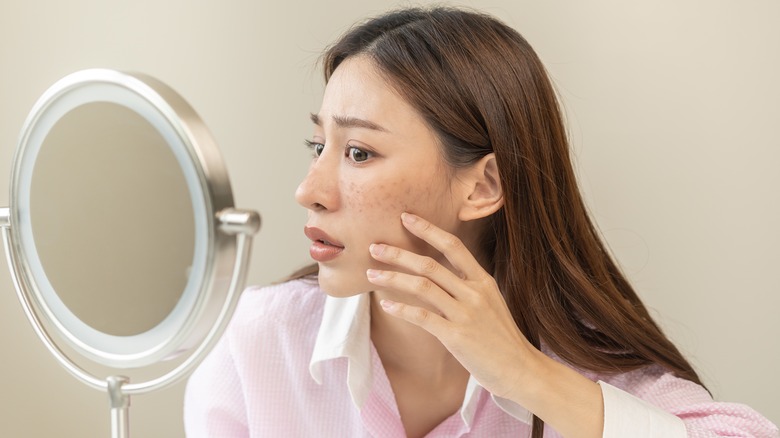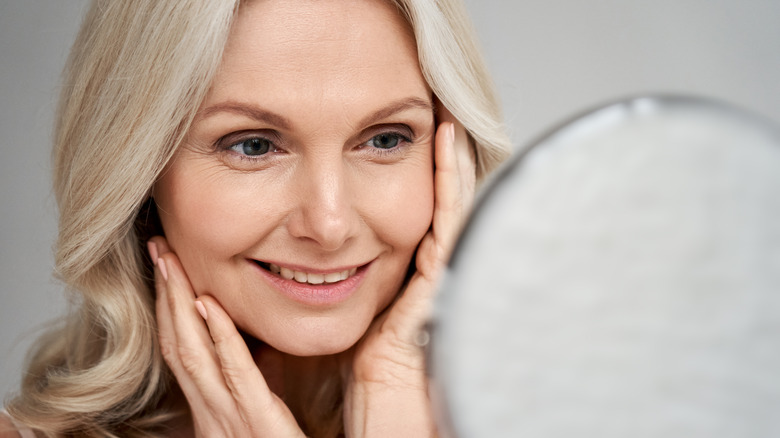Mistakes You Don't Want To Make When Using Niacinamide For Skincare
We may receive a commission on purchases made from links.
With so many skincare products on the market and so many ingredients claiming to be better than the next, it can be difficult to know exactly what type of products are right for your skin. And while different skincare ingredients offer a multitude of benefits, with most dermatologists and experts recommending a regular routine using multiple different products, one ingredient you will want to consider working into your own routine is niacinamide.
Whether you prefer a serum or cream formula, when used correctly, niacinamide can be a powerful anti-aging skincare ingredient, and can also help combat common issues like acne, scarring, redness, and eczema. "Niacinamide reduces sebum production, which can both help prevent acne and also diminish shine," says board-certified dermatologist Kenneth Howe, M.D., via Real Simple. It also works to help repair the skin's barrier, helping it to retain moisture — aiding in the fight against dry skin and eczema. Lian Mack, M.D., adds via Sunday Edit that it can even act as an antioxidant and aid in protecting your skin from free radicals and environmental pollution.
Not only will properly incorporating niacinamide into your skincare routine allow it to work its magic to the fullest but doing so will also help ensure you avoid any potential negative effects. Here are the biggest mistakes to avoid making when using the ingredient in your skincare routine.
Using too much
When first starting out with niacinamide, it's important to use small amounts initially until you know how your skin will tolerate it. While the ingredient is not known for being harsh or irritating, some people are more sensitive to niacinamide than others. Cosmetic chemist Perry Romanowski tells Allure that your skin's general level of sensitivity as well as your genetics play a role in determining just how much niacinamide is "too much" for you. "There are some people who feel a stinging sensation and those people tend to be more reactive to niacinamide than others," he says.
At particularly high concentrations, dermatologist Marisa K. Garshick, M.D. says via Sunday Edit that niacinamide can cause skin irritation and redness. "While having anti-inflammatory properties, when niacinamide is used in higher concentrations, it may cause contact dermatitis, which may manifest itself as redness and a rash," she says. To decrease the risk of irritation, board-certified dermatologists Rachel Nazarian, M.D., and Lucy Chen, M.D. both recommend via Everyday Health starting out with a product that contains no more than 5% niacinamide, as this concentration is tolerable for most people. However, if you have particularly sensitive skin, dermatologist Shari Sperling, M.D. says via Today that concentrations exist as low as 2%, which is a good option if you are nervous about how your skin will react. Be warned that some formulations contain double the tolerable amount for most people, so always read the label carefully when shopping for products.
Not pairing it with other active ingredients
Niacinamide, like many other skincare ingredients, often works best when used in conjunction with other active ingredients. Fortunately, niacinamide tends to react well with most other skincare ingredients, making it relatively easy to incorporate into your existing routine.
Dermatologist Marina Peredo, M.D., recommends via Sunday Edit using a niacinamide serum after cleansing and before moisturizing. Because niacinamide is water based, it will have a hard time absorbing directly into your skin if you have already applied a thick moisturizer. Dermatologist Marisa K. Garshick, M.D., adds that niacinamide can safely be paired with glycolic acid, kojic acid, or arbutin to aid in cases of hyperpigmentation. It can even be paired with the notoriously tricky retinol to help soothe your skin and aid in tolerating the harsh ingredient.
If you struggle with breakouts, Gretchen Frieling, M.D., a triple board-certified dermatopathologist, tells Real Simple that niacinamide can safely be paired with other acne-fighting ingredients like salicylic acid to maximize the positive effects of both. Combining the two ingredients can help reduce your skin's oil production as well as dissolve excess oil, which can help keep your skin free of breakouts caused by oil buildup. Niacinamide is also a great partner for hyaluronic acid, as combining the two can maximize their hydrating benefits. Frieling also adds that niacinamide is often paired with alpha-hydroxy acids, since the AHAs help exfoliate dead skin cells, making it easier for the niacinamide to absorb into the skin.
Giving up too quickly
When people claim that certain skincare products aren't effective, it's often simply because they didn't give them enough time to properly work. "Most skincare products do not deliver immediate effects, so in order to truly benefit them, it is important to use them consistently and be patient," says dermatologist Brendan Camp, M.D. via Sunday Edit. Trusting the process is the best way to see results.
According to Paula's Choice, you should expect on average to start to notice results after two to four weeks of daily niacinamide usage if you apply it both morning and night. Fortunately, niacinamide does not make your skin more sensitive to the sun, so it's safe to use it during both your morning and nightly routine, as long as your skin tolerates it. In fact, Healthline says that it can actually help protect your skin from UV rays by working to repair skin cells that have been damaged by the sun while also protecting them from further sun damage.
It's important not to discontinue the use of niacinamide after seeing results, as continued treatment is essential in reaping long-term benefits. And though initial results can usually start to be seen after a few weeks, as long as you are consistently and regularly using it, you can expect your skin's texture, dryness, discoloration, and overall appearance to continue to improve over time.
Thinking it's too late to start
It's never too late in life to begin using niacinamide in your daily skincare routine. Pharmacist Shabir Daya tells Glamour Magazine it works so well on all different types of skin textures and hydration levels from dry to oily that people of all ages can benefit from regular usage. So, if you didn't discover niacinamide as a teen when first starting your skincare routine — or in your 20s and 30s when you learned to perfect it — you can still reap its benefits now.
In fact, mature skin can benefit even more from niacinamide than other types of skin due to its anti-aging properties. According to clinical facialist Kate Kerr via Glamour Magazine, "Niacinamide increases cellular energy, improving cell turnover, microcirculation and antioxidant protection — all of this helps slow skin aging." Daya also adds via Glamour Magazine that regular niacinamide use helps boost your skin's collagen production — a key component in the fight against fine lines, wrinkles, and loss of skin elasticity — thanks to its skin-plumping properties.
